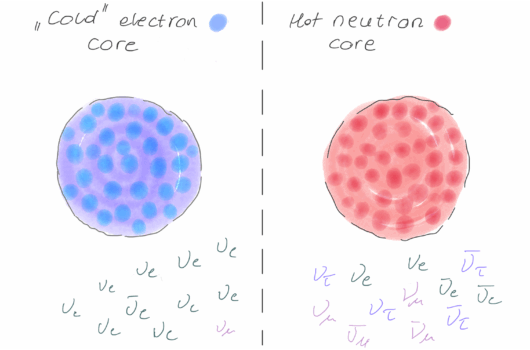𝜈p-process in Core-Collapse Supernovae: Imprints of General Relativistic Effects
𝜈p-process in Core-Collapse Supernovae: Imprints of General Relativistic Effects
View
Abstract
The origin of certain proton-rich isotopes in the solar system, particularly ![]() and
and ![]() , has been a long-standing puzzle. A promising explanation is the 𝜈p-process, which is posited to operate in the neutrino-driven outflows that form inside core-collapse supernovae after shock revival. Recent studies have identified several relevant physical effects that influence the yields of this process. The impact of General Relativity (GR) on the 𝜈p-process yields, however, remains unexplored. In this work, we perform a comparative analysis of the time-integrated yields of the p nuclei up to
, has been a long-standing puzzle. A promising explanation is the 𝜈p-process, which is posited to operate in the neutrino-driven outflows that form inside core-collapse supernovae after shock revival. Recent studies have identified several relevant physical effects that influence the yields of this process. The impact of General Relativity (GR) on the 𝜈p-process yields, however, remains unexplored. In this work, we perform a comparative analysis of the time-integrated yields of the p nuclei up to ![]() in Newtonian and fully GR neutrino-driven outflows, using a detailed model of a time-evolving outflow profile. The two main GR effects are the gravitational shift of neutrino energies and post-Newtonian corrections to the gravitational potential. These effects together suppress the production of seed nuclei, significantly boosting the 𝜈p-process yields in our
in Newtonian and fully GR neutrino-driven outflows, using a detailed model of a time-evolving outflow profile. The two main GR effects are the gravitational shift of neutrino energies and post-Newtonian corrections to the gravitational potential. These effects together suppress the production of seed nuclei, significantly boosting the 𝜈p-process yields in our ![]() progenitor model. Most of the production of the crucial
progenitor model. Most of the production of the crucial ![]() and
and ![]() p isotopes in this model occurs in an optimal time window, 1-3 seconds after shock revival. Interestingly, the same does not apply to the shielded isotope
p isotopes in this model occurs in an optimal time window, 1-3 seconds after shock revival. Interestingly, the same does not apply to the shielded isotope ![]() , a large fraction of which is produced in the subsequent ejecta. The impact of GR on this isotope is especially large, with its final abundance boosted by a factor of 25 compared to a Newtonian calculation. In our
, a large fraction of which is produced in the subsequent ejecta. The impact of GR on this isotope is especially large, with its final abundance boosted by a factor of 25 compared to a Newtonian calculation. In our ![]() model, an additional GR effect is observed: the outflow transitions to the supersonic regime several seconds into the explosion, causing the yields to drop. This study quantifies the important role GR effects play in the 𝜈p-process and provides guidance for identifying optimal conditions in future self-consistent supernova simulations.
model, an additional GR effect is observed: the outflow transitions to the supersonic regime several seconds into the explosion, causing the yields to drop. This study quantifies the important role GR effects play in the 𝜈p-process and provides guidance for identifying optimal conditions in future self-consistent supernova simulations.




